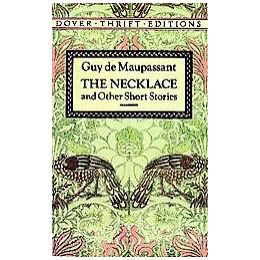Guy de Maupassant’s “The Necklace” is situational irony written in 1884. The story was written in a time when there were very distinct social classes primarily determined by one’s birth. It is about a woman who cannot come to terms with her position in the middle class. Although she knows she cannot escape her class, she refuses to accept it gracefully.
It is through Matilde that Maupassant develops the story’s irony. This is reflected through Matilde’s daydreaming, which only serves to torment her, the loss of the necklace borrowed for the show, which only worsens their economic position, and finally, their unnecessary sacrifice.
The irony begins with Matilde’s frequent daydreaming. She is a beautiful and charming woman who feels “herself destined for all delicacies and luxuries” (4). Fate, however, placed her among the middle class where life was very simple. For her, the only means to a more affluent class was through her imagination.
She dreams of “large silent anterooms, expensive silks and of achievement and fame that would make her the envy of all other women” (4). What she fails to realize is that these daydreams only make her more dissatisfied with her real life. As a result, she becomes more focused on what she does not have rather than what she does have.
Contributing to the irony is the borrowed necklace. Matilde’s husband brings a coveted dinner invitation home, and her first reaction is a concern for appearances. She tells her husband that they cannot possibly go because she has “nothing to wear” (5). Her husband agrees to buy her a new dress. This, however, is not enough for Matilde; she needs jewelry. She explains that, without jewelry, she will appear “shabby in the company of rich women” (6).
In her quest to present herself as a wealthy woman, she decided to borrow a “superb diamond necklace” (6) from a friend. Unfortunately, upon arriving home, Matilde noticed that the necklace was lost. When the necklace cannot be found, Matilde and her husband have no choice but to replace it. As a result, Matilde’s desire to appear part of the upper class has only succeeded in making them part of a lower one.
Without a doubt, the most ironic part of the story is Loisel’s unnecessary sacrifice. The Loisel’s decision to replace the necklace without telling the owner of its loss. “In a shop in the Palais-Royal, they found a necklace that seemed to them exactly like the one they were looking for” (8). They secure the thirty-six thousand for the necklace from Mr. Loisel’s inheritance and in the form of loans.
They struggle and live in poverty for ten years to pay off the necklace. By now, Matilde looks old. “She had become the strong, hard, and rude woman of poor households” (9). Matilde is walking along the Champs-Elysees when she encounters the friend who loaned her the necklace. Her friend is shocked when Matilde finally tells her about the necklace.
It is then that Matilde learns that the necklace she and her husband toiled to replace was only costume jewelry. Even among the rich, there are appearances to keep up. Maupassant, through irony, shows us that in pursuit of wealth or status it is easy to forget what one already has to appreciate. Also, appearances are just that, no matter what class you belong to.
Because Matilde did not understand this, desire to rise above the middle class was replaced with a desire to merely rise above poverty.

